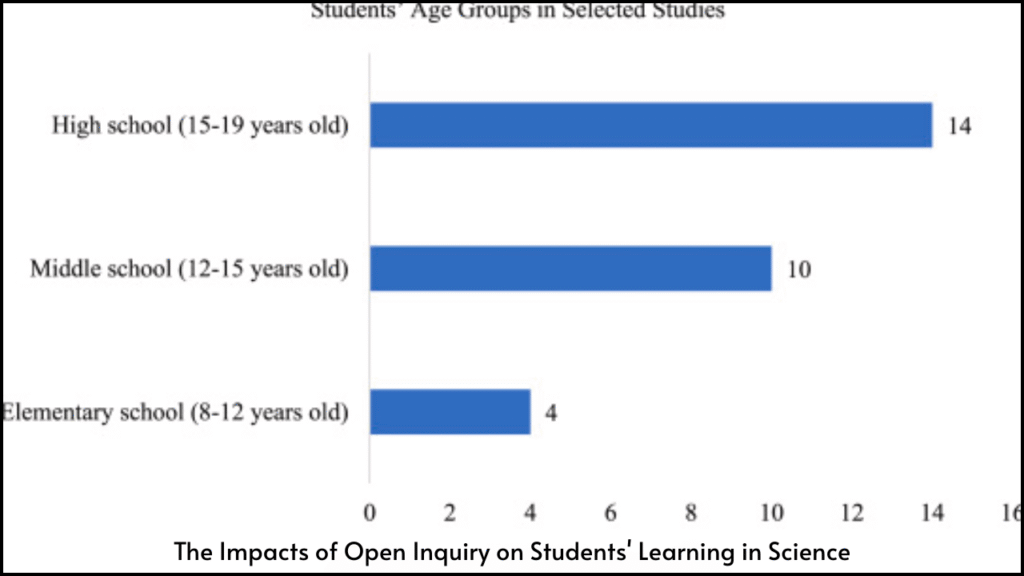
Science education plays a vital role in shaping how students think, question, and explore the natural world. Open inquiry, as a teaching approach, provides learners with the freedom to ask their own questions, design experiments, and construct explanations without relying on rigid teacher-directed steps. Such a strategy shifts the focus from memorization of facts to deeper engagement with scientific processes. Student curiosity and creativity flourish when they are empowered to guide their own investigations, leading to stronger critical thinking, motivation, and long-term retention of knowledge.
Table of Contents
Overview of Open Inquiry in Science Learning
| Aspect | Description |
|---|---|
| Definition | A student-centered approach where learners generate questions, design methods, collect data, and draw conclusions independently. |
| Core Feature | Autonomy of learners in formulating and pursuing scientific questions. |
| Learning Outcome | Development of higher-order thinking, problem-solving skills, and conceptual understanding. |
| Teacher’s Role | Guide, facilitator, and mentor rather than direct instructor. |
| Student’s Role | Active investigator and decision-maker throughout the scientific process. |
| Key Benefit | Deeper understanding of science concepts and improved engagement. |
Main Features of Open Inquiry
- Student Autonomy – Learners choose research questions and decide how to investigate them.
- Process-Oriented Learning – Focus is placed on the scientific process rather than only on the outcome.
- Exploration of Real Problems – Students explore meaningful, real-life science issues instead of hypothetical textbook scenarios.
- Ownership of Learning – Inquiry creates a sense of responsibility as students manage their own projects.
- Reflection and Evaluation – Learners assess both their findings and their methods, leading to self-improvement.
Positive Impacts on Students’ Learning
1. Development of Critical Thinking
- Students analyze problems independently rather than relying on teacher instructions.
- Questioning, hypothesizing, and evaluating evidence sharpen reasoning abilities.
- Misconceptions are addressed through evidence-based exploration.
2. Improvement in Scientific Skills
- Learners gain experience in experimental design, observation, data analysis, and interpretation.
- Skills such as measuring, graphing, and systematic recording are naturally embedded.
- Students build habits of accuracy and precision.
3. Strengthening of Conceptual Understanding
- Open inquiry allows learners to see the direct connection between theory and practice.
- Students link classroom concepts with real-world applications.
- Misunderstood ideas get corrected when tested in practical scenarios.
4. Enhancement of Motivation and Engagement
- Curiosity drives student participation when they investigate their own questions.
- Ownership of learning boosts self-confidence.
- The thrill of discovery makes science learning enjoyable.
5. Growth of Collaboration and Communication
- Group projects encourage teamwork, shared responsibilities, and peer-to-peer teaching.
- Students explain their reasoning and present findings, improving communication skills.
- Scientific discussions promote active listening and critical dialogue.
Challenges Faced in Open Inquiry
| Challenge | Explanation | Possible Solution |
|---|---|---|
| Time Constraints | Inquiry projects often require a longer time compared to traditional lessons. | Integrating small-scale inquiries into the regular curriculum. |
| Teacher Preparation | Teachers need advanced training to guide without dominating. | Professional development programs on inquiry-based strategies. |
| Assessment Issues | Measuring learning outcomes is complex due to open-ended tasks. | Use of rubrics, reflective journals, and portfolios. |
| Resource Limitations | Laboratories, tools, and materials may be insufficient. | Creative use of local resources and low-cost experiments. |
| Student Readiness | Some learners struggle with open-ended tasks initially. | Scaffolding through guided inquiry before transitioning to open inquiry. |
Comparison Between Traditional and Open Inquiry Approaches
| Aspect | Traditional Teaching | Open Inquiry |
|---|---|---|
| Learning Role | Teacher-centered, passive listening | Student-centered, active exploration |
| Questioning | Questions provided by the teacher/textbook | Questions generated by learners |
| Process Control | Teacher controls procedures | Students design and modify methods |
| Assessment | Focus on correct answers | Focus on reasoning and process |
| Motivation | External (grades, teacher approval) | Internal (curiosity, self-discovery) |
| Knowledge Retention | Short-term memorization | Long-term conceptual understanding |
Strategies for Effective Implementation
- Gradual Introduction – Begin with guided inquiry before shifting to full independence.
- Scaffolded Support – Provide tools, templates, and checkpoints to avoid confusion.
- Integration with Curriculum – Align inquiry tasks with required standards and topics.
- Use of Technology – Digital simulations, data analysis software, and virtual labs enhance accessibility.
- Reflective Practices – Encourage students to write journals and reflect on their inquiry journey.
Case Studies of Open Inquiry in Science Education
- High School Biology – Students investigated the effect of different fertilizers on plant growth, leading to an understanding of ecological balance and agricultural sustainability.
- Middle School Physics – Learners designed experiments on pendulum motion, gaining insight into energy conservation and experimental accuracy.
- Chemistry Lab Projects – Open inquiry tasks on chemical reactions promoted a deeper grasp of reaction rates and environmental safety practices.
Other Important Information
- Role of Teachers – Teachers act as mentors, asking guiding questions rather than providing direct answers.
- Inclusivity – Open inquiry benefits diverse learners by allowing them to pursue topics of personal interest.
- Long-Term Skills – Beyond science, open inquiry cultivates transferable skills such as problem-solving, teamwork, resilience, and independent thinking.
- Real-Life Applications – Students learn to apply scientific thinking in daily decisions, from health choices to environmental awareness.
Summing Up
Open inquiry brings a transformative shift in science education by making learning active, meaningful, and student-driven. Critical thinking, scientific skills, motivation, and collaboration are strengthened when learners take ownership of their investigations. Although challenges like resource needs and time management exist, proper strategies and teacher support make open inquiry a highly effective model. Science classrooms that embrace open inquiry prepare students not only for academic success but also for lifelong problem-solving and informed citizenship.





